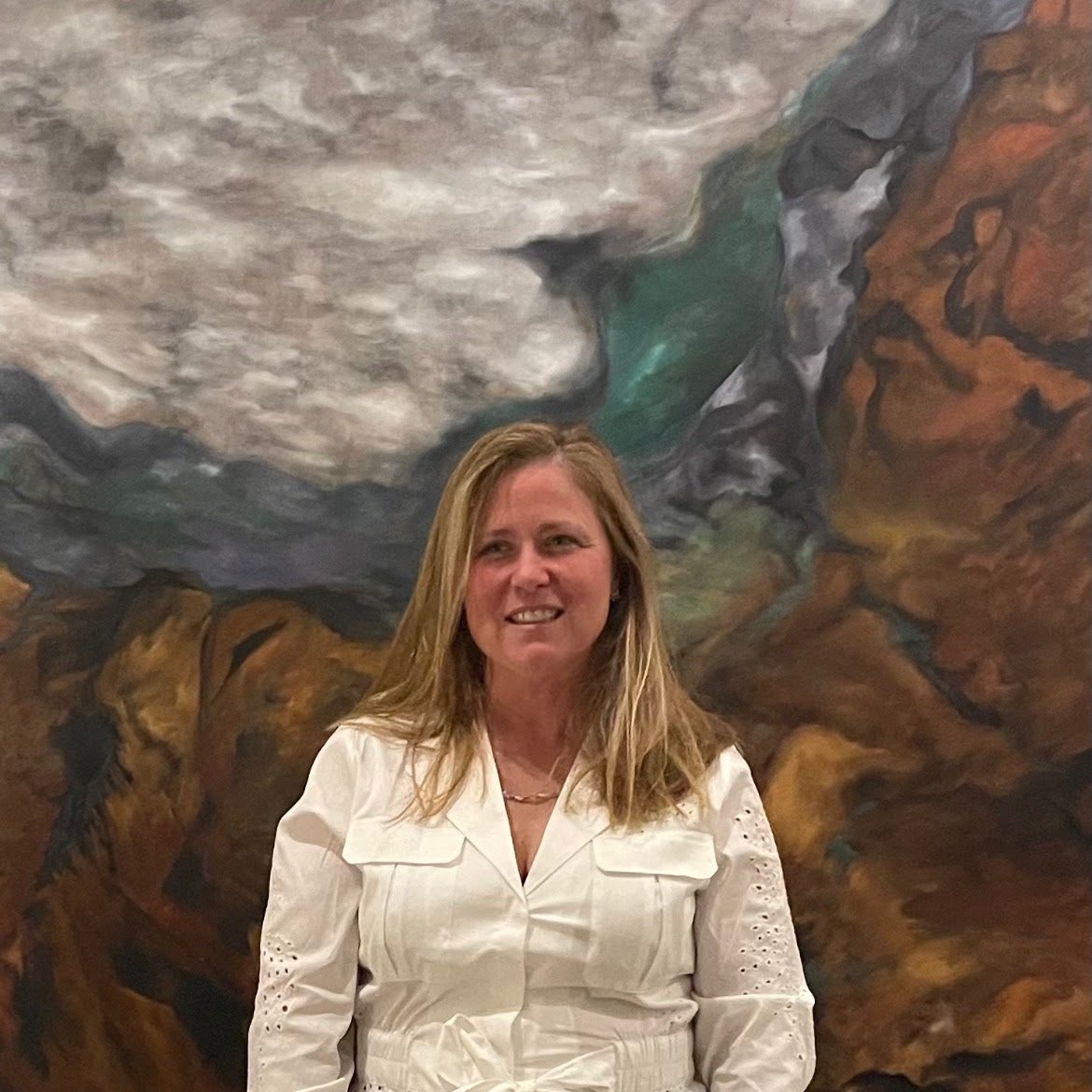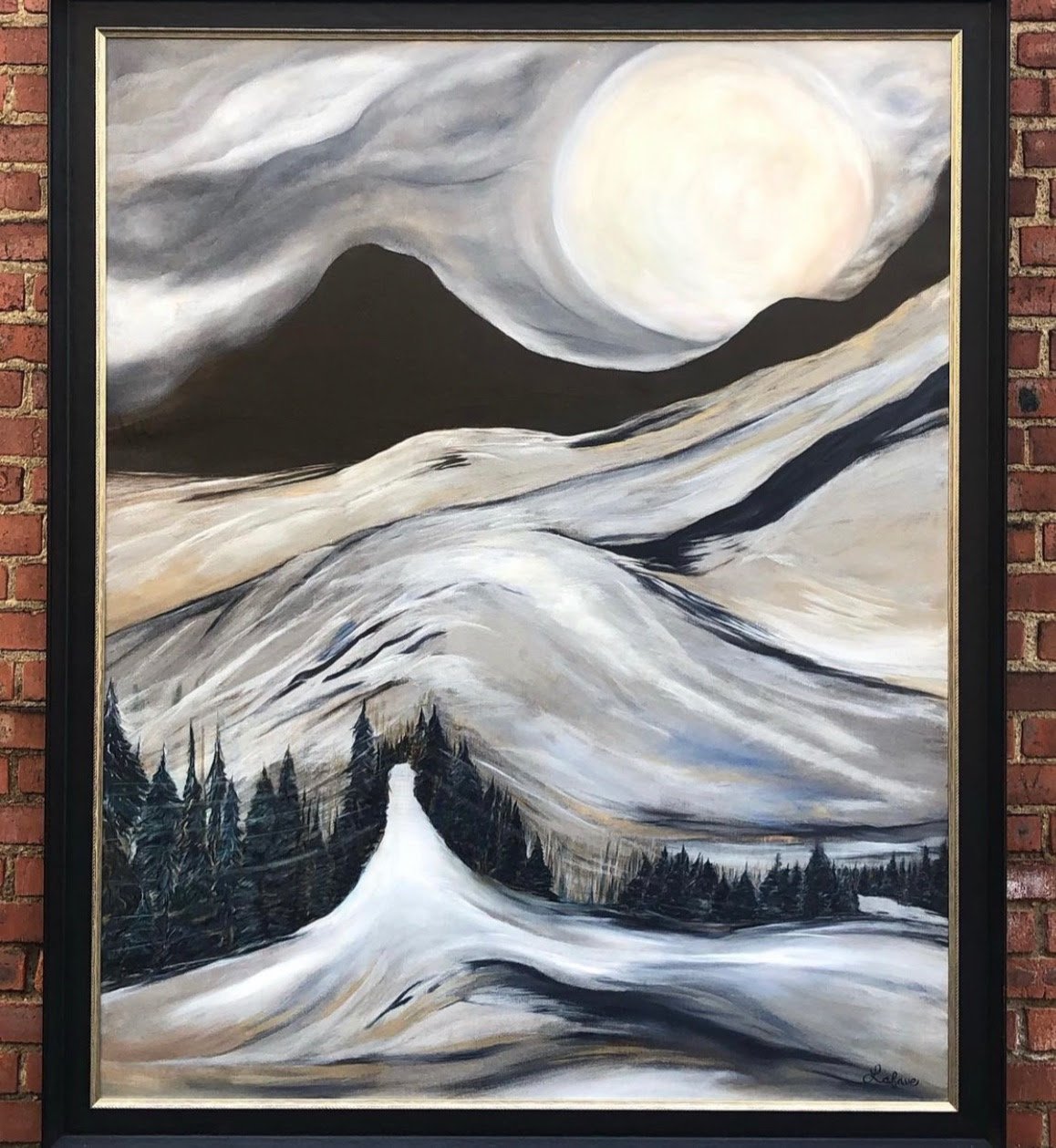March 2022 / Artist Interview
Featuring Evelyn Lafave McCarthy
Lake Louise, acrylic on canvas, 48" x 52"
Whistler Moon, acrylic + oil on canvas, 48" x 60"
“When making a painting I have learned not to be limited by stringent boundaries, but to search for balance and harmony in the blending and manipulation of shape, color and subtle textural variation. A combination of landscape and horizon emerge through the process and are woven together in the rhythms of color, sometimes calm, often dramatic."
- Evelyn Lafave McCarthy
Currently Showing at Amoré Gallery
Abstract Landscapes
March 3- April 3, 2022
1. What are you currently working on?
I am working on a fresh new series inspired by mountains and water, basically Sea and Ski. These paintings continue to be landscape in subject but they are different from my other paintings that have many built-up layers of paint, rather the new work is crisp and direct. The two most recent paintings compose a beautiful diptych. They look fitting together and are striking alone.
Amoré Gallery, March 2022
2. Which of your work are you most proud of creating?
The painting that I continue to admire and appreciate- my absolute favorite painting that I have ever made is called 'Desert Landscape'. I made this painting in preparation for my first solo show at Case Western Reserve University at Mather Gallery in 2001. It now hangs in my living room where I check on it every day. This painting embodies the kind of work that I aspire to do. It is a very large painting at a little larger than 6’ x 5’. A small amount of gold shines and comes alive as the light of the day progresses. I hope to achieve more paintings like this one. I find it to be very satisfying.
Desert Landscape, acrylic +oil on canvas, 75.5" x 63"
3. What art have you seen or experienced that inspires you most?
That is a very long and complex answer! I can summarize but that is at the expense of so many painted images, architectural sites, ancient ruins, sculptors and artists that I have been admiring my entire life. I was a double major in Art History and Fine Art during my undergraduate years in Connecticut and received a Masters in Art History from Case Western Reserve and the Cleveland Museum of Art after having worked at WOLF’s auctioneers. I have had the opportunity to seek out and visit a variety of art museums in the US as well as Europe, where I made it my mission to visit many major museums and architectural sites as I could thanks to a back-packing trip and an Eurail Pass in my mid twenties. I’ve seen a lot of interesting art created from different cultures and time periods. Here are the top four most influential that impact my production, process and mindset.
John Gregoropoulos
Cave Paintings, Lascaux France
One of my favorite pieces is an abstract painting by Greek Abstract Expressionist John Gregoropoulos (1921-2012). It is a picture of a Greek house in blue and black in stark contrast and with half of the painting in black- a depiction of a Greek home during the air raids of World War II. There is a skinny strip of exhaust from a plane running overhead. This painting was a graduation gift from my parents and it was meaningful to me because it was made by my art professor at Connecticut College, who taught me painting and independent study and helped me to discover a passion for painting, a method to painting and an obsession with painting. I think of him often when I’m working about what he would say about what I’m doing or how I’m working. “Stop tickling the canvas!” or “Use as little medium as possible! Use the best paint you can get your hands on and use more pigment.” or “Don’t get sentimental about that part of the painting, no one is that interested in that detail?” “Don’t use yellow; it is a complicated color for artists!” That last one is a bit of a challenge to me. Even 30 years later I try to use yellow in defiance. He was influential to me.
Another experience which really inspired me occurred in the Dordogne region of France in the Vézère Valley in the mid-1990s. I spent a summer working at an archaeological site at Abri Castanet at Castel-Merle in Sergeac, France. There, as a low-ranking pre-graduate school student on a joint NYU, University of Paris run graduate program, I used a sieve to screen material from a little marked-off square at a dig-site which dated back some 30,000 years. I was very lucky that in my square I found four of the seven carved, shaped, bone beads that were discovered that summer. The lead archaeologists were pleased with my hard work. At the time only a few archaeologists a day for a few months a year were allowed to enter the nearby Lascaux 1 Cave to learn and inspect. As circumstance would have it, an archaeologist canceled and a spot opened up one day and as thanks for my volunteer work at Castanet, I was granted the opportunity to fill the spot at Lascaux and visit the famous caves. I still remember the haunting images of bison, horses and stag animating the walls in a low flickering torchlight and the figures bringing a sense of motion to the cave as I walked through with the caretaker. The shape of the walls undulating below the pigment added heft and certainty to the figures of the animals and the paint was deep and intense and I tried to imagine the people who created this art 16-17,000 years ago.
There is something so natural about using the most raw earth colors in paint that always reminds me of those early beautiful cave paintings. I keep a picture from a page that I pulled out of an archaeology magazine taped to the wall in my studio. It is an inspiration wall of all kinds of images of landscapes and mountains and rivers, the Northern lights, beautiful trees and fields, but there is always a picture of the raw paintings from Lascaux on the wall nearby. I’ll never forget seeing that.
Euthymides Krater
Cleveland Art Museum
Another experience which shaped my art-making comes from an art historical perspective. As an Art History graduate student I was invited to assist under Jenifer Neils of Case Western Reserve University at an archaeological site at Morgantina, Sicily. There I worked at doing photography cataloging and shard drawings and profiles of the volumes of broken bits of pottery that were uncovered from the 5th century BC Greek settlement there. In the tiny museum there, a real treasure is the Euthymides Attic red-figured Krater. Professor Neils has produced much research from the site and related to that ancient vessel. It was my privilege to illustrate the frieze on both sides of that large volute krater and my drawings have been reproduced in Professor Neil’s research and articles and the American Journal of Archaeology. I enjoyed studying the images and thinking about the artist who painted them. Again the raw colors of the red earth and black inspired my earlier work. There is a tension in my work between specificity and ambiguity but in the end a general, harmonious blending of shape, color and paint wins. I do not create paintings based on the frieze of this ancient piece of pottery, but learning and knowing about it and studying it and something about the materials helps to inform my art and it inspires my thinking.
Lastly, I’m just going to say Cézanne! There is never a time that I would tire of entering a gallery to see a beautiful, landscape painting by Cézanne of Mt. St. Victoire or the surrounding French countryside. These paintings look effortless but they are calculated and the brushwork nearly architectural. These paintings are really in my opinion just beautiful. I attended a summer art program in Lacoste, France through the Cleveland Institute of Art in my 20s. There, I developed a love of the locale where Cézanne produced these paintings and the surrounding medieval villages and limestone hilltop towns. A visit to nearby Roussillon, showed the pigmented hills where artists of Cézanne’s time were known to collect pigment to grind and use in their paintings. What is found there is reminiscent of the pigment that I saw on the walls at Lascaux, the raw colors I have studied with ancient Greek pottery, all very essential and natural colors that I like. This ‘earthiness’ coupled with fresh greens and blues and yellows in the painting of Cézanne continue to inspire.
4. How has the Covid 19 Pandemic influenced your art and activities in Cleveland?
While many aspects of Covid were devastating for my family and very disruptive to our normal routines, there are some good things that have come out of it. I have had the opportunity to spend more focused time at home in my studio and I have redirected my thoughts, energy and activities to once again making my large-scale, abstract landscape paintings. My friend Kate Geraci, who owns Amoré Gallery has been exhibiting my work in her gallery, which is in the same exact location where I used to have an art studio twenty-one years ago! It is a real joy to be back in that space and exhibiting my work and collaborating with a team of phenomenal people who I enjoy being with at the gallery. I feel that I have come full circle. I am energized by this new path.
In addition to my artwork, my husband Patrick and I have purchased my parent’s beloved Tartan 40 sailboat ‘Cricket’ and have embarked on a journey of exploring the Great Lakes and making friends with other boaters and like-minded Lake Erie enthusiasts. Learning to sail and operate an old sailboat is much like creating my abstract landscape paintings. Each time it is a challenge, there is an element of the unknown, and creative problem solving is essential to pull it all together. It all keeps me on my toes!











